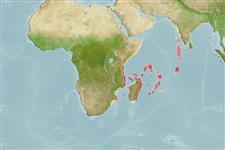Classification / Names
Nomi Comuni | Sinonimi | Catalog of Fishes(Genere, Specie) | ITIS | CoL | WoRMS | Cloffa
>
Blenniiformes (Blennies) >
Tripterygiidae (Triplefin blennies) > Tripterygiinae
Etymology: Helcogramma: Greek, helkos, -eos, -ous = ulcer, sore + Greek, gramma = letter, mark (Ref. 45335); alkamr: Named after the original Arabic name for Madagascar (Jazirat al-Qumr), ‘al-Kamr’ or al-Qumr, transferred to the Comoro Islands in the 15th century by the historian Ahmad Ibn Mãjid. Specific epithet is used as a noun in apposition..
Environment: milieu / climate zone / depth range / distribution range
Ecologia
marino associati a barriera corallina; distribuzione batimetrica 0 - 20 m (Ref. 75031). Tropical
Western Indian Ocean: from Zanzibar to Rodrigues, north to Seychelles.
Size / Peso / Age
Maturity: Lm ? range ? - ? cm
Max length : 3.2 cm SL maschio/sesso non determinato; (Ref. 75031)
Short description
Morfologia | Morfometria
Spine dorsali (totale): 11 - 17; Raggi dorsali molli (totale): 10-11; Spine anali 1; Raggi anali molli: 19 - 20; Vertebre: 35 - 36. Diagnosis: Medium fusiform tripterygiid, less than 4.0 cm SL. Dorsal fin III + XII-XIV + 10-11, first fin low; anal fin I + 19; pectoral rays 16 (1+8+7); pelvic fin I, 2, spine short and hidden, segmented rays simple, partially united by membrane. Vertebrae 10 + 25-26. LL total lateral scales 36-39, pored series 19-25 (121) scales, terminates below junction of 2nd and 3rd dorsal fins; nape, underside of caudal peduncle, and bases of anal fin and first and second dorsal fins scaleless. Mandibular pores 5+1+5. Snout short, profile blunt. Head length 3.7 in SL; eye 2.9; maxilla 2.3 in HL. Male overall brown with vertical bars reddish brown extending to midline; dark brown blotches and smaller bluish-white spots along midline. Female head white with brown spots; body cream with 6 pairs of semi-bars. Geographical variation in coloration and meristic characters: fishes from Mauritius have less pigmentation than those from Comoro and Seychelles Islands. Caudal vertebrae 26 in Mauritius, 25 in Comoro and Seychelles Islands. (Ref. 75031).
Adults occur in a wide array of habitats; clear and turbid water, between 0-20m depth, amongst coral rock and rubble with some sand, and in a high energy tidal environment amongst large boulders and coral heads (Ref. 75031). Eggs are hemispherical and covered with numerous sticky threads that anchor them in the algae on the nesting sites (Ref. 240). Larvae are planktonic which occur primarily in shallow, nearshore waters (Ref. 94114).
Life cycle and mating behavior
Maturità | Riproduzione | Deposizione | Uova | Fecundity | Larve
Holleman, W., 2007. Fishes of the genus Helcogramma (Blennioidei: Tripterygiidae) in the Western Indian Ocean, including Sri Lanka, with description of four new species. Smith. Bull. 7:51-81. (Ref. 75031)
IUCN Red List Status (Ref. 130435)
Human uses
Informazioni ulteriori
Nomi ComuniSinonimiMetabolismoPredatoriEcotossicologiaRiproduzioneMaturitàDeposizioneSpawning aggregationFecundityUovaEgg development
Age/SizeAccrescimentoLength-weightLength-lengthLength-frequenciesMorfometriaMorfologiaLarveDinamica popolazioni larvaliReclutamentoAbbondanzaBRUVS
BibliografiaAcquacolturaProfilo di acquacolturaVarietàGeneticaElectrophoresesEreditarietàMalattieElaborazioneNutrientsMass conversion
CollaboratoriImmaginiStamps, Coins Misc.SuoniCiguateraVelocitàModalità di nuotoArea branchialeOtolithsCervelliVista
Strumenti
Special reports
Download XML
Fonti Internet
Estimates based on models
Preferred temperature (Ref.
123201): 25.5 - 28.9, mean 27.5 °C (based on 245 cells).
Phylogenetic diversity index (Ref.
82804): PD
50 = 0.5000 [Uniqueness, from 0.5 = low to 2.0 = high].
Bayesian length-weight: a=0.00562 (0.00258 - 0.01228), b=3.08 (2.89 - 3.27), in cm total length, based on LWR estimates for this (Sub)family-body shape (Ref.
93245).
Trophic level (Ref.
69278): 3.0 ±0.3 se; based on size and trophs of closest relatives
Resilienza (Ref.
120179): Alto, tempo minimo di raddoppiamento della popolazione meno di 15 mesi (Preliminary K or Fecundity.).
Fishing Vulnerability (Ref.
59153): Low vulnerability (10 of 100).
